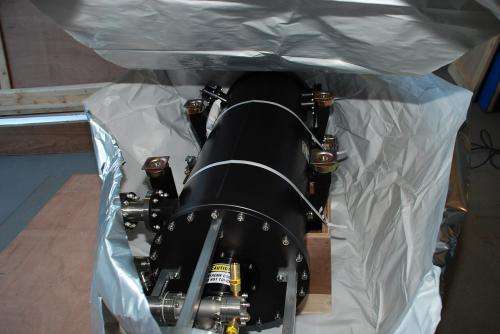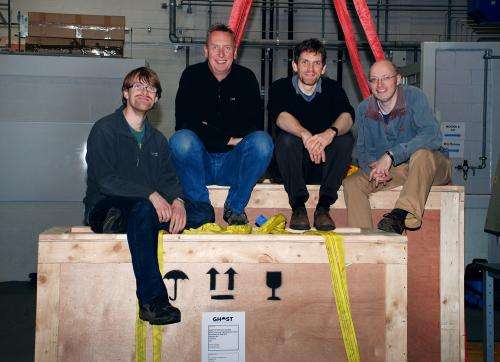Scottish engineers deliver instrument to study 'greenhouse gases' from a NASA unmanned aircraft

Engineers in Edinburgh used to building instruments to look at the atmospheres of stars and distant planets have turned their attention to the atmosphere of Earth. A prototype instrument designed and built at the UK Astronomy Technology Centre (UK ATC) is on its way to NASA in the USA to help improve our understanding of the Earth's natural carbon cycle.
Supported by the Natural Environment Research Council (NERC), researchers from the Universities of Leicester and Edinburgh will use the instrument to measure the emission and uptake of greenhouse gases. Understanding these gases is a prerequisite for managing future levels of carbon dioxide to support effective international agreements and national emission reduction programmes.
The UK ATC engineers, who are part of the Science and Technology Facilities Council (STFC), normally design and build spectrometers that study planetary and galaxy formation in the early universe and stellar nurseries, but have now applied these instrument techniques, building high resolution spectrometers with very low noise, to the challenges we face here on Earth.
The prototype instrument they have built at the Royal Observatory in Edinburgh is for the GHOST (GreenHouse Observations of the Stratosphere and Troposphere) project. It will sit in the belly of a NASA Global Hawk Unmanned Aerial vehicle, at altitudes up to 20,000m, above the troposphere where most of the Earth's weather occurs, for just over a day on one tank of fuel.
Prof Gillian Wright, Director of the UKATC, said: 'The shipping of GHOST to NASA is an important milestone in transferring technology developed for astronomy to innovative instruments for Earth observations. It will offer the UK additional capabilities to deploy GHOST or similar instruments on our own national airborne research platforms.'

GHOST will provide fine-scale greenhouse gas measurements that are expected to fill a measurement gap left by space-borne platforms and conventional in situ instrumentation. It will collect sunlight that has been reflected from the ocean surface below and disperse it into a spectrum from which individual molecules can be identified. This will allow atmospheric columns of carbon dioxide, methane and carbon monoxide to be measured over huge swaths of the Pacific Ocean. The researchers will then combine this data with a large-scale numerical weather model to understand the atmospheric transport of the gases.
Andy Vick, Innovations Manager at STFC's UKATC facility said "In order to make GHOST work on the aircraft we had to take into account extreme pressure, temperature and vibrational variations, which we wouldn't normally have to consider when building instruments for a telescope, and then make the instrument operate autonomously, so that even if direct communication with the instrument is lost it will still take useful scientific data. In addition, we have worked with Leicester scientists to develop qualification and calibration methods that can work in the laboratory or on a desert airstrip."
Dr Hartmut Boesch, the science lead at the University of Leicester, said 'GHOST is a truly unique instrument and, thanks to its innovative technology, will allow us for the first time to observe the total amount of the key carbon gases carbon dioxide, methane and carbon monoxide at the same time. This, combined with the capability of the Global Hawk to fly for over a day, will give us an unprecedented view on the atmosphere.'
Prof Paul Palmer, science co-lead at the University of Edinburgh, added "GHOST represents a new collaboration between groups that have in the past focused on Astronomy and Earth observation, and a strategic alliance within Edinburgh, and I hope these will ultimately lead to more opportunities in the future."
GHOST
GHOST is a project of the Universities of Leicester and Edinburgh and the UK ATC (instrument design and build).
GHOST will use a novel multiple-order spectrograph originally developed in Edinburgh for ground and space based infrared astronomy which can examine infrared light between 1 and 2.4 microns. It will do this by collecting sunlight that has been reflected from the ocean surface below and dispersing it into a spectrum from which individual molecules can be identified. This will allow atmospheric columns of carbon dioxide, methane and carbon monoxide to be measured over huge swaths of the Pacific Ocean. This data will then be combined with a large-scale numerical weather model to understand the atmospheric transport of the gases.
The GHOST instrument will be despatched from Edinburgh to the NASA Armstrong Flight Research Centre at Edwards Air Force Base in the California desert, where it will be flown for the first time in early 2015. The instrument has already been through ground based testing and calibration at the UKATC, including observations of real solar spectra through the open doors of the integration laboratory. The GHOST team will travel to California in January 2015 to take the instrument through functional, vibration and high altitude simulation testing to achieve flight clearance approval. It will then have its first engineering test flight at the end of February with science flights following in March.
Provided by Science and Technology Facilities Council




















